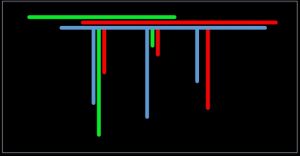Why Cross Functional Agile Teams Look Like Icicles – and Members are T-shaped
One of the main challenges when transitioning to agile ways of working is, that rather than the individual being responsible, it is now the team being responsible. For everything. Personally a big hurdle to overcome, but even bigger for the star developer. If you nurse the transition careful enough, you have a great foundation for a cross functional team.

What is the difference between an agile team and other teams?
An agile team is a team of individuals, that bring individual skill sets and solve tasks just like anyone else at work will do. The main difference between agile teams and traditional (aka waterfall, sequential) development teams, lies in the organisation of the work where the agile team, as a unit, is responsible for the work delivered. And further, that the agile team -as a unit, will take any credit given for the delivered quality, just as the agile team is responsible for continuously improving the settings they work in.
The skills sets needed to do agile development are to a large extent similar to what you need in other development situations; if you develop software then you need developer competencies and tester competencies. Plus competencies in identifying, describing and prioritising requirements, competencies in sales, deployment and maintenance (in broad sense) etc.
On an agile team you combine the skill sets into a cross functional team, so that the team, as a unit, can identify, describe and prioritise the requirements, and can factor in sales, deployment and maintenance. Further, the team on an ongoing basis combine that with current details on the development and knowledge of which parts of the required solution is currently shipable.
What does it take to become a cross functional team?
A team with a number of specialists is expectedly a team with a high level of competencies. Are they good at solving tasks? Well, most likely they are. But; it really depends on what kind of tasks and whether they can solve them independently, or not.
A cross functional team is also a team with a lot of competencies – but one of the highly important skills is the ability to collaborate. A fundamental to collaborating is to understand what the other person says and be able to deliver your own message in a way that the other person will understand, even if it is very detailed and outside your own specialist domain.
Effectively this requires that some competencies be shared across the team members, but at the same time without requiring that all team members are to be exact clones of each other. Just image the cost of this team where all are super stars in all the aspects of requirement identification and prioritisation, development, testing and sales, deployment and maintenance! Potential dream team but likely not the perfect place to work as the individual’s room for improvement is already used.
So how should I then mix a team?
Well, what you are looking for is a combination of deep skills in the relevant domains (development and testers in relevant technologies), business domain knowledge, analysis and problem solving skills and general collaboration skills, just to mention those relevant across different business domains.
And for the team to be effective and robust (eg in times of individuals absence) each skill should, as a minimum, be held by two and ideally three people. Of course, you prefer collaboration and problem solving skills to be held by everyone, but generally you can do with less.
A person with deep skills in one domain and some skills in other areas is called T shaped, due to the deep knowledge in one area and broad knowledge in other areas – just as the shape of the letter T.
So for your team  you should be looking for a combined skill set looking like T’s put closely together on a row TTT. This is illustrated here with three T shaped profiles, each having deep skills in one primary area and some skills in other areas.
you should be looking for a combined skill set looking like T’s put closely together on a row TTT. This is illustrated here with three T shaped profiles, each having deep skills in one primary area and some skills in other areas.
But nature has already given us a great picture for this; a row of icicles.
How do I start a cross functional team – or at least get an indication of where I am?
Actually, by asking the question you are already far into it! The point is to be aware of each individuals specialist skills, but also to pay attention to the collaborative skills, problem solving skill and general ability to improve on process and tools related to the agile process. The questions can be asked by a ScrumMaster, Product Owner, or revealed by an Agile Specialist coaching the team.
Any skill you identify shortage of, you may be able to grow on the team, or add to the team as and when a new team member is to be included.
So good luck, growing a team of icicles!
Majken Vildrik Thougaard, Independent Agile Specialist & Owner of VILMA Consulting
PS: Once you have a cross functional team, you are well on your way to having a high performance team.